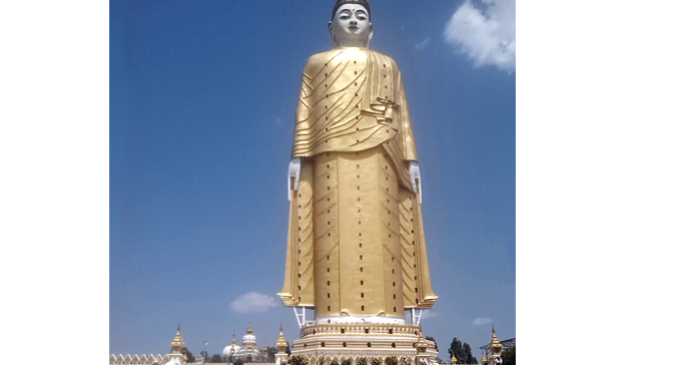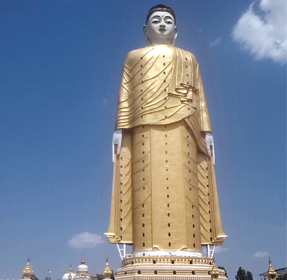The world’s largest and tallest standing Buddha Image

The late Maha Bodhi-ta-htaung Sayadaw monk Ashin U Narada was an extraordinary missionary monk who performed preaching and promoting of Buddha Dhamma, meditating and building religious monuments of superlative dimension. Besides he was an accomplished alchemist producing “stones” of mercury compound to cure all diseases.
His missionary journeys abroad covered East, West and South East Asia as well as Austrialia and Newzealand—Thailand, India, Nepal, Malaysia, Singapore, Srilanka, Japan, US, South Korea, England, Indonesia, Laos and Peoples’ Republic of China.
It was in Japan, that when he visited Yushiku Ameta, the then tallest standing Budddha Image, he was inspired to build such a Buddha Image in his country.
He first revealed his wish to one of his followers U Htun Ney Win who at that time was a military serviceman. The name “Htun Ney Win” was very auspicious Sayadaw told him and that the work of building a big statue should be initiated by him. Bogyi Htun Ney Win donated Kyats 30,000 out of his hard-earned savings, and so began the story of this world’s gigantic structure on the high hill range “Mt. Khatatkan in Monywa District, Upper Myanmar.
The precinct of Maha Bodhi-ta-htaung monastic complex is 250 acres wide, with hills, valleys and plains covered with natural and planted trees and bushes. Many religious edifices have already emerged in the vast space, mak-ing a pleasant scenery. When the news spread, devotees from far and near began pondering when, and how. Some had mixed feelings, possible or not possible, especially when Sayadaw chose the site on the summit of Zabu hill, 1150 feet high above sea level. Incredible idea of Sayadaw. But where are the money, material, technology and experts? Sayadaw had most experience of building religious monuments of no small size in that area.
On May 8, 1995 began the ground breaking ceremony. Monks chanted Paritta to consecrate the site. The following days voluntary labour contributors from nearly 16 villages and Monwya town came and by turn in teams they did all spade works. Military service men from North-West Command also participated. At the depth of 35 feet, in the hard rocky hill, all attempts even by dynamite were resisted by the core. The expert’s consensus stopped further digging and began laying foundation with stones from quarrier in other hills.
The construction of the pedestal was the next step. It was an octagonal design, measuring 43 feet and 6 inches east to west and 124 feet and 6 inches north to south. Two entrances are on the north and south sides. Inside are teak staircases to go up. The standing Buddha Image entitled “Ley Kyun Satkya” (‘Satkya Muni Buddha of four cardinal lands’) has 33 storeys, each storey is 12 feet high up to the 10th level. From the 11th level to the 33rd level, each storey is 13 feet high.
Voluntary labour contributors were religiously inspired. They came from different places of the country. Sayadaw monk provided gratis food, clothing, shelter and medical care. Inspite of extensive solar heat especially in summer in that dry zone, contributors of voluntary labour increased by leaps and bounds. Working hours changed to avoid intense heat. When the construction reached higher level, 3-ton, 16-ton and tower cranes were purchased and used.
Without supervising engineer, the construction completed up to the 10th level, at over 120 feet high. The engineers U Ye Aung (Yangon) and Mr Sun Khone, engineer U Aung Than Tun (Yangon), U Tin Htun Aung (Sagaing) and U Myint Lay of South Khatatkun village advisors U Myint Aung and U Than Sein performed their works successfully. Monk participants were headed by Sayadaw U Sobita who regularly chanted Paritta (Protective Buddhist Sutta) for the safety of all at site. As the construction rose, many natural and accidental dangers were involved. On a high rise being built on a high hill, the wind constantly blows, making continuations of work impossible. But Sayadaw and monks chanted Kamawaca Sutta and put up Buddha Sasana flags at every corner. Besides, Maha Bodhi-tahtaung Sayadaw fixed up on construction frames plates engraved with cabalistic symbols and diagrams. Miraculously the wind subsided and the work continued, happily and confidently. At the height of 1150 + over 300 feet, there are dangers of electrification, thunder attraction and lightning. So scientific safety measures were taken and installed at the structure. Marrows (ash pumpkins) were hung at all strategic corners to ward off thunder and lightning.
Only bamboo scaffoldings were used for this high rise Buddha statue of 424 feet on the hill of 1150 feet above sea level. Bamboo lasts at least two years and they are easier and cheaper to maintain and safer for Myanmar workers. By 2004, 27 levels had been comple-ted. The problem was to get correct and realistic face and body of standing Buddha. If was Gantgaw Tahtaung Sayadaw Monk Agga Vamsa of Pyin Oo Lwin who drew the image. He had done such kind of work before. But on such extraordinary height, heavy materials, iron, steel, cement concrete stone and brick posed great problem of transportation, let alone using them.
Engineer U Maung Maung Soe gave the solution. He had successfully invented light but strongly resistent fibre for air planes and water crafts. He got the latest fibre technology from Malaysia. His colleagues U Hla Min (Golden Hawks International Ltd) and U Aung Thein Htun successfully moulded with fibre the face design of Sayadaw Agga Vamsa. U Maung Maung Soe used Laser Pointer moulding the face on the ground. Then the face mould was lifted up to the height piece meal. At this juncture, the three engineers U Aung Than Tun, U Htun San and adviser U Thein Sein felt extreme desire to become monk till they completed the work. So these three monk engineers did their work to the finish.
When the entire frame of the Image was completed on 31 January 2007, sacred relics and votive objects were enshrined in relic chambers on the 31st storey. On the head were 108 embossed sitting Buddhas under 108 embossed sculpture of Bodhi Trees.
Named “Ley Kyun Satkya”, the gigantic standing Buddha Image is indeed an engineering wonder and artistic beauty. Its measurements are as follows:
Each Eye …. 10 feet.
Face from chin to the hair knot …40 feet.
Width of face …… 38 feet.
Frontlet made of bronze plated with gold.
Completion date 19 February 2007.
The great Image was consecrated in accordance with the traditional rites and ceremony lay 1000 monks and 1000 nuns and many lay devotees led by Sayadaw on 20 February 2007 at 7 am auspicious time.
The height of the Image 424 feet exceeds the height of Yuriku Ameta of Japan which is 393 feet and 9 inches high. In every storey is the museum or display room of Bud-dha’s life stories and all pertaining to Buddhism. The top floor opens up boundless panorama of all directions. Electric lifts operate daily.
One marvels and admires at the engi-neering feats of Sayadaws, local lay engineers and generosity and cooperation of devotees and wellwishers at home and abroad.
The standing Buddha Image entitled “Ley Kyun Satkya” (‘Satkya Muni Buddha of four cardinal lands’) has 33 storeys, each storey is 12 feet high up to the 10th level. From the 11th level to the 33rd level,
each storey is 13 feet high.
The great Image was consecrated in accordance with the traditional rites and ceremony lay 1000 monks and 1000 nuns and many lay devotees led by Sayadaw on 20 February 2007 at 7 am auspicious time.
Sithu Dr. Khin Maung Nyunt
./wp-content/uploads/2018/10/Emirate-Online-TDY.png)

















There are no comments at the moment, do you want to add one?
Write a comment